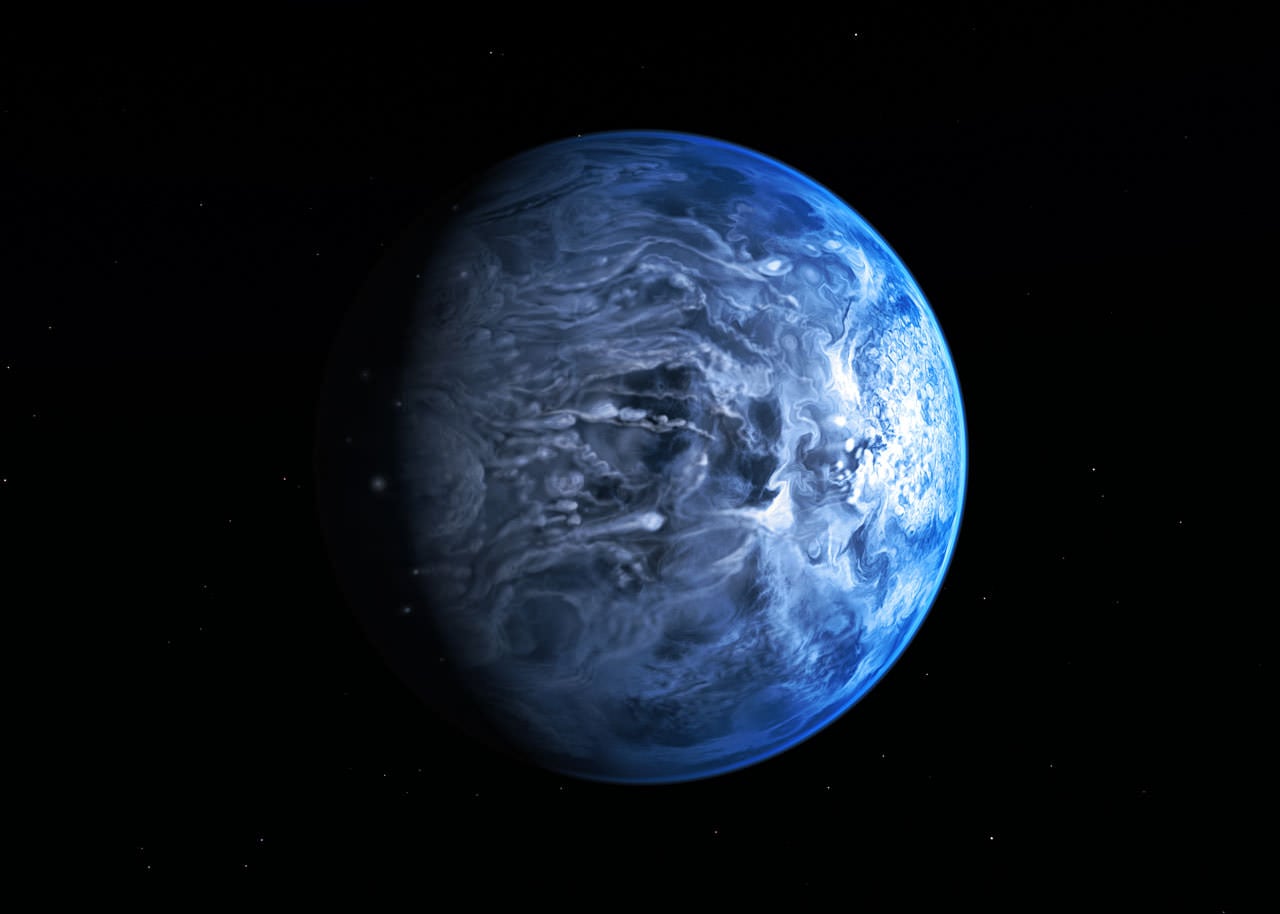Since its discovery in 2005, exoplanet HD 189733b has been one of the most-observed planets orbiting another star, as its size, compact orbit, and proximity to Earth has made it a relatively easy target -- as extrasolar planets go. From previous studies,
astronomers thought the planet may have an enticing blue-sky atmosphere.
Now, further examinations with the Hubble Space Telescope have confirmed this planet really does harbor an azure blue atmosphere, very similar to Earth's ocean blue color.
But this is no 'pale blue dot' ocean world. It is a huge gas giant orbiting very close to its host star. It gets blasted with X-rays from its star -- tens of thousands of times stronger than the Earth receives from the Sun -- and endures wild temperature swings, reaching scorching temperatures of over 1,000 degrees Celsius. Astronomers say it likely rains glass – sideways -- in howling 7,000 kilometer-per-hour winds.
Nope, not a place you'd want to visit.
But the new Hubble observations of its color are the first time an exoplanet's color has been measured and confirmed. The astronomers measured how much light was reflected off the surface of HD 189733b — a property known as albedo.
"This planet has been studied well in the past, both by ourselves and other teams," says Frédéric Pont of the University of Exeter, UK, co-author of a
new paper
. "But measuring its colour is a real first — we can actually imagine what this planet would look like if we were able to look at it directly."
HD 189733b is a Jupiter-sized extrasolar planet orbiting a yellow dwarf star that is in a binary system called HD 189733 in the constellation of Vulpecula, near the Dumbell Nebula, approximately 62 light years from Earth.
The planet's blue atmosphere does not come from the reflection of a warm ocean, but is due to a hazy, turbulent atmosphere thought to be laced with silicate particles, which scatter blue light. Earlier observations using different methods have reported evidence for scattering of blue light on the planet, but these most recent Hubble observations give robust confirming evidence, the researchers said.
To make their measurements, the team used Hubble's Space Telescope Imaging Spectrograph (STIS) to look at the system before, during, and after the planet passed behind its host star as it orbited. As it slipped behind its star, the light reflected from the planet was temporarily blocked from view, and the amount of light observed from the system dropped – not by much, about one part in 10,000 -- but this was enough for STIS to determine the albedo.
"We saw the brightness of the whole system drop in the blue part of the spectrum when the planet passed behind its star," explains Tom Evans of the University of Oxford, UK, first author of the paper. "From this, we can gather that the planet is blue, because the signal remained constant at the other colours we measured."
Albedo is a measure of how much incident radiation is reflected. The greater the albedo, the greater the amount of light reflected. This value ranges from 0 to 1, with 1 being perfect reflectivity and 0 being a completely black surface. The Earth has an albedo of around 0.4.
According to the
team's paper,
HD 189733b has an albedo of 0.4 ± 0.12.
The team says this determination will help in future studies of the atmospheres of other extra solar planets, as well as continuing the studies of one of the most-examined planets orbiting another star.
"It's difficult to know exactly what causes the colour of a planet's atmosphere, even for planets in the Solar System," says Pont [5]. "But these new observations add another piece to the puzzle over the nature and atmosphere of HD 189733b. We are slowly painting a more complete picture of this exotic planet."
Loading player...
var sdfile = 'http://www.spacetelescope.org/static/archives/videos/medium_flash/heic1312a.flv';var imagefile = 'http://www.spacetelescope.org/static/archives/videos/videoframe/heic1312a.jpg';var flashsrc = 'http://www.spacetelescope.org/static/djangoplicity/shadowbox3/libraries/mediaplayer5/player.swf';var sharelink = 'http://www.spacetelescope.org/videos/heic1312a/';var sharecode = '';var gaid = 'UA-2368492-6';var ipadfile = 'http://www.spacetelescope.org/static/archives/videos/medium_podcast/heic1312a.m4v';var mobilefile = 'http://www.spacetelescope.org/static/archives/videos/medium_podcast/heic1312a.m4v';var hdfile = 'http://www.spacetelescope.org/static/archives/videos/hd_and_apple/heic1312a.m4v';;
 Universe Today
Universe Today
